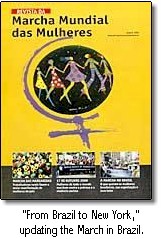"They marched. And so? What did it accomplish?" Though sometimes it may seem insubstantial, subjective, impalpable, or insufficient-even vastly insufficient-the answer to this question, from women around the world, was: a lot!
The year 2000 was a time of actions, projects and petitions; 2001 was a year of assessment, where women took stock of the gains and formulated strategies for the future.
Reports sent in by women's movements from around the planet are full of promise for the future. We had no news, however, of the outcome of some campaigns.
Women's groups have conducted countless struggles together. It is not always clear which gains were obtained exclusively by the March. Still, here is a sampling:
Raising women's visibility

The World March of Women highlighted the condition of women in countries around the world. Reports produced by the national coordinating bodies contain statistical information on women's role in society. Collective actions threw light on often-neglected issues.
Because of workshops and training sessions that were organized almost everywhere, women have a better understanding of international issues and can make the link between global economic policies and their daily lives.
The March made people aware "that the struggle is not only being conducted in our communities, but also at the national and international levels," say women in Ecuador.
The World Trade Organization, the importance of micro-credit in economic development, the sex trafficking of women and girls, and the victims of caste wars were among the topics dealt with by women in India.
Most groups presented their demands to political leaders, so they can no longer claim ignorance of women's concerns. In a speech delivered on the national holiday on January 6, 2001, the President of India referred to the need to reduce violence against women.





